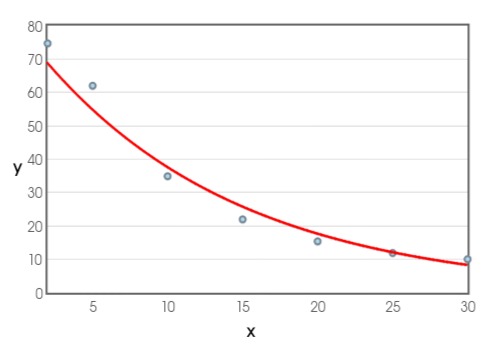
Concept explainers
a.
To find: The temperature in this experiment can be modelled as an exponential function of time.
a.
Answer to Problem 34E
this problem deals with cooling, so use Newton’s law of cooling to model the system.
Explanation of Solution
Given information: A temperature probe is removed from a cup of hot chocolate and placed in ice water. The data in given table were collected over the next
| Experimental Data |
| Time(sec) Temperature |
The rate at which an object’s temperature is changing at any given time is roughly proportional to the difference between its temperature and the temperature of the surrounding medium. Since this problem deals with cooling, so use Newton’s law of cooling to model the system.
b.
To find: The best exponential model.
b.
Answer to Problem 34E
best exponential model
Explanation of Solution
Given information: A temperature probe is removed from a cup of hot chocolate and placed in ice water. The data in given table were collected over the next
| Experimental Data |
| Time(sec) Temperature |
Formula used: Exponential Regression equation
Calculation: best exponential model
Graph of the model on a scatter plot of the data

c.
To find: Time taken the probe will reach
c.
Answer to Problem 34E
the probe will reach
Explanation of Solution
Given information: A temperature probe is removed from a cup of hot chocolate and placed in ice water. The data in given table were collected over the next
| Experimental Data |
| Time(sec) Temperature |
best exponential model
d.
To find: The temperature of the hot chocolate when the probe was removed.
d.
Answer to Problem 34E
The temperature of the hot chocolate when the probe was removed
Explanation of Solution
Given information: A temperature probe is removed from a cup of hot chocolate and placed in ice water. The data in given table were collected over the next
| Experimental Data |
| Time(sec) Temperature |
best exponential model
The probe was removed when
Chapter 7 Solutions
Calculus 2012 Student Edition (by Finney/Demana/Waits/Kennedy)
Additional Math Textbook Solutions
Introductory Statistics
Intro Stats, Books a la Carte Edition (5th Edition)
Elementary Statistics: Picturing the World (7th Edition)
Algebra and Trigonometry (6th Edition)
Thinking Mathematically (6th Edition)
College Algebra with Modeling & Visualization (5th Edition)
 Calculus: Early TranscendentalsCalculusISBN:9781285741550Author:James StewartPublisher:Cengage Learning
Calculus: Early TranscendentalsCalculusISBN:9781285741550Author:James StewartPublisher:Cengage Learning Thomas' Calculus (14th Edition)CalculusISBN:9780134438986Author:Joel R. Hass, Christopher E. Heil, Maurice D. WeirPublisher:PEARSON
Thomas' Calculus (14th Edition)CalculusISBN:9780134438986Author:Joel R. Hass, Christopher E. Heil, Maurice D. WeirPublisher:PEARSON Calculus: Early Transcendentals (3rd Edition)CalculusISBN:9780134763644Author:William L. Briggs, Lyle Cochran, Bernard Gillett, Eric SchulzPublisher:PEARSON
Calculus: Early Transcendentals (3rd Edition)CalculusISBN:9780134763644Author:William L. Briggs, Lyle Cochran, Bernard Gillett, Eric SchulzPublisher:PEARSON Calculus: Early TranscendentalsCalculusISBN:9781319050740Author:Jon Rogawski, Colin Adams, Robert FranzosaPublisher:W. H. Freeman
Calculus: Early TranscendentalsCalculusISBN:9781319050740Author:Jon Rogawski, Colin Adams, Robert FranzosaPublisher:W. H. Freeman
 Calculus: Early Transcendental FunctionsCalculusISBN:9781337552516Author:Ron Larson, Bruce H. EdwardsPublisher:Cengage Learning
Calculus: Early Transcendental FunctionsCalculusISBN:9781337552516Author:Ron Larson, Bruce H. EdwardsPublisher:Cengage Learning





